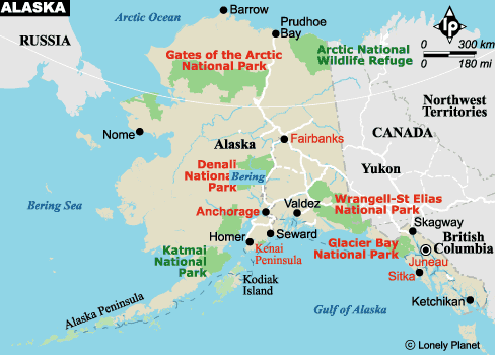|
||||||||||||
|
In 2004, we decided to take a tour of Alaska and signed up with Bill Reed, a former extension agent in Jefferson County, for a 11 day tour of the interior of this great state. We had looked at the possibility of a cruise and liked the thoughts of seeing more of the interior of the state than what a cruise would offer. I have known Bill for over twenty five years and worked with him in the Agricultural Extension Service. I knew the trip would be an "experience", and we were not disappointed. From the museums of Anchorage and Fairbanks to the 307 friendly people and a few old crabs of Seldovia, Alaska, the trip was an experience. As Forest Gump would say, the bed and breakfasts were like a box of chocolates, "you never know what you are going to get". Overview On March 30, 1867, the United States agreed to purchase Alaska from Russia for $7.2 million dollars, or about two cents an acre; "Seward's Folly" many called it, after Secretary of State William H. Seward. A check for $7,200,000.00 was issued on August 1, 1868 and made payable to Edouard de Stoeckl, the Russian Minister to the United States. Alaskans approved statehood in 1946 and adopted a state constitution in 1955. On January 3, 1959, President Eisenhower announced Alaska's entrance into the Union as the 49th state. Alaska is the largest state in the union being about 1/5 the size of the lower 48 states. To the demise of Texans, it is 2 1/2 times the size of Texas. The state contains 586,412 square miles or 365 million acres. Alaska has 34,000 miles of shoreline which is more than all of the lower 48 states and Hawaii. Alaska's population as of July 1998 exceeded 621,000 with an estimated 258,782 living in Anchorage alone. Most of Alaska is uninhabited pristine wilderness and protected for future generations. Another interesting fact about Alaska is the tax situation. There is no state income tax and very few towns and cities have a sales tax. Government financing is done through property tax and oil revenues. Every resident of Alaska that has lived there at least one year is a recipient of a dividend from the Alaska Permanent Fund. The Permanent Fund was established through a constitutional amendment approved by Alaska voters in 1976. The constitutional amendment and its supporting statutes set aside at least 25% of certain mineral revenues paid to the State for deposit into a public savings account to be invested for the benefit of the current and all future generations of Alaskans. Over the past five years the annual payment to each resident has averaged $1645 per person per year.
We left Knoxville early on the morning of June 12, 2004, arriving in Chicago around 7:00 am and flying directly from Chicago to Anchorage arriving in Anchorage 1:30 pm Alaska time. The time is 4 hours behind East Tennessee time. Over the next few days, we took the Alaska Railroad to Denali National Park, traveling by rail on to Fairbanks. From Fairbanks, we flew Alaska Airlines back to Anchorage and took a chartered bus through Palmer, Homer, Sodotna, and Seward before going back to Anchorage and flying back to Knoxville, arriving back in Knoxville at 9:00 am on Wednesday, June 23, 2004. Over the next several pages, I hope to show the highlights of this trip and some of the scenery of the Last Frontier of the United States.
|

